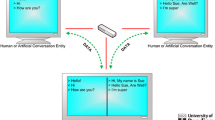Abstract
In this paper, we look at the possibility of a machine having a sense of humour. In particular, we focus on actual machine utterances in Turing test discourses. In doing so, we do not consider the Turing test in depth and what this might mean for humanity, rather we merely look at cases in conversations when the output from a machine can be considered to be humorous. We link such outpourings with Turing’s “arguments from various disabilities” used against the concept of a machine being able to think, taken from his seminal work of 1950. Finally we consider the role that humour might play in adding to the deception, integral to the Turing test, that a machine in practice appears to be a human.

Harjit Mehroke for a; C.D. Chapman for b
Similar content being viewed by others
References
Al-Katib M (1999) Joke-telling in Jordanian society: a sociolinguistic perspective. Humor Int J Humor Res 12(3):261–288
Attardo S (2001) Humorous texts: a semantic and pragmatic analysis. Mouton de Gruyter, Berlin/New York
Bennett D (2012) Artificial intelligence, I’ll say why computers can’t joke? http://www.bloomberg.com/news/articles/2012-03-23/artificial-intelligence-ill-say-dot-why-computers-cant-joke
Benton G (1988) The origins of political jokes. In: Powell C et al (eds) Humor in society: resistance and control. St. Martin’s Press, New York, pp 33–55
Binstead K (1996) Machine humour: an implemented model of puns. PhD Thesis, Edinburgh University
Boden M (1998) Creativity and artificial intelligence. Artif Intell 103(1–2):347–356
Copeland B (2004) The essential Turing—the ideas that gave birth to the computer age. Clarendon Press, Oxford
De Bruyn P (1989) My grandfather the hunter: a humorous translation from Afrikaans to English. Meta 34:79–83
Dennett D (1997) Kinds of minds: toward an understanding of consciousness. Basic Books, New York
Dybala P, Ptaszynski M, Higuchi S, Rzepka R, Araki K (2010) Multiagent system for joke generation: humour and emotions combined in human-agent conversation. J Ambient Intell Smart Environ 2(1):31–48
Dybala P, Ptaszynski M, Higuchi S, Rzepka R, Araki K (2008) Humor prevails!—implementing a joke generator into a conversational system. In: Proceedings of AI 2008 advances in artificial intelligence, vol 5360, LNCS, pp 214–225
Farghal M (2006) Accidental humour in international public notices displayed in English. J Intercult Commun (12)
Fowler H, Fowler F (eds) (1995) The concise Oxford dictionary of current English, 9th edn. Clarendon Press, Oxford, p. 486
Grice H (1975) Logic and conversation. In: Cole P, Morgan JL (eds) Speech acts. Academic Press, New York, pp 41–58
Moor J (2003) The status and future of the Turing test. In: Moor JH (ed) The Turing test—the Elusive standard of artificial intelligence. Kluwer, Dordrecht, The Netherlands, pp 197–214
Penrose R (1994) Shadows of the mind. Oxford University Press, Oxford
Rickman P (1999) The philosopher as joker. Philos Now 25:10–11
Ritchie G, Manurung R, Pain H, Waller A, Black R, O’Mara D (2007) A practical application of computational humour. In: Proceedings of computational creativity, pp 91–98
Shah H (2010) Deception detection and machine intelligence in practical Turing tests. PhD thesis, The University of Reading
Shah H, Henry O (2005) Confederate effect in human-machine textual interaction. In: Proceedings of 5th WSEAS int. conf. on information science, communications and applications (WSEAS ISCA), Cancun, Mexico, ISBN: 960-8457-22-X, pp 109–114, 11–14 May 2005
Shah H, Warwick K, Bland I, Chapman C, Allen M (2012) Turing’s imitation game: role of error-making in intelligent thought. Turing in Context II, Brussels, 10-12 October, pp 31–32, 2012. http://www.computing-conference.ugent.be/file/14. Presentation available here: http://www.academia.edu/1916866/Turings_Imitation_Game_Role_of_Error-making_in_Intelligent_Thought
Shah H, Warwick K, Carpenter R, (2008) Can a machine tell a joke?. In: Proceedings of European conference on computing and philosophy, Montpellier, June 2008
Shah H, Warwick K (2010) Testing Turing’s five-minutes, parallel-paired imitation game. Kybernetes 39(3):449–465
Shah H, Warwick K, Vallverdu J, Wu D (2016) Can machines talk? Comparison of Eliza with modern conversation systems. Comput Hum Behav 58:278–295
Smith P (1991) The joke machine: communicating traditional humour using computers. In: Bennett G (ed) Spoken in jest. University of Sheffield Press, Sheffield
Sterrett S (2003) Turing’s two tests for intelligence. In: Moor J (ed) The Turing test—the Elusive standard of artificial intelligence. The Netherlands, Kluwer, pp 79–97
Stevenson A (ed) (2010) Oxford dictionary of English. Oxford University Press, Oxford
Turing A (1950) Computing machinery and intelligence. Mind LIX(236):433–460
Warwick K (2011) Artificial intelligence: the basics. Routledge, Abingdon
Warwick K (2012) Not another look at the Turing Test!. In: Bielikova M, Friedrich G, Gottlob G, Katzenbeisser S, Turan G (eds.) Proceedings of SOFSEM 2012: theory and practice of computer science (Lecture notes in computer science), vol 7147. Springer, pp 130–140
Warwick K, Shah H (2016a) Turing’s imitation game: conversations with the unknown. Cambridge University Press, Cambridge
Warwick K, Shah H (2014a) Good machine performance in practical Turing tests. IEEE Trans Comput Intell AI Games 6(3):289–299
Warwick K, Shah H (2014b) Assumption of knowledge and the Chinese room in Turing test interrogation. AI commun 27(3):275–283
Warwick K, Shah H (2015a) Can machines think? A report on Turing test experiments at the royal society. J Exp Theor Artif Intell. doi:10.1080/0952813X.2015.1055826
Warwick K, Shah H (2015b) Human misidentification in Turing tests. J Exp Theor Artif Intell 27(2):123–135
Warwick K, Shah H (2016b) Effects of lying in practical turing tests. AI & Soc 31(1):5–15
Warwick K, Shah H (2016c) The importance of a human viewpoint on computer natural language capabilities: a Turing test perspective. AI & Soc 31(2):207–221
Warwick K, Shah H, Moor J (2013) Some implications of a sample of practical Turing tests. Mind Mach 23:163–177
Author information
Authors and Affiliations
Corresponding author
Rights and permissions
About this article
Cite this article
Shah, H., Warwick, K. Machine humour: examples from Turing test experiments. AI & Soc 32, 553–561 (2017). https://doi.org/10.1007/s00146-016-0669-0
Received:
Accepted:
Published:
Issue Date:
DOI: https://doi.org/10.1007/s00146-016-0669-0




